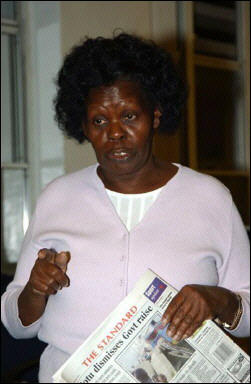 Do you think we have improved? You be the judge...Released November 1, 2008
Do you think we have improved? You be the judge...Released November 1, 2008
SummarySince mid-2007 the Kenya Police has engaged in an orgy of extra-judicial killings and disappearances. In the last year and a half, with the connivance of Kenya's political leadership, over 500 young men have been killed or disappeared. This September 2008 Kenya National Commission on Human Rights report, The Cry of Blood, is an account of these crimes and a call for the United Nations to intervene.
Despite being submitted to the authorities in Kenya and to the United Nations Committee Against Torture, the Report is not publicly available in Kenya, even on the official website of the Kenya National Commission on Human Rights.
The Report contains evidence of a high-level policy to assassinate Kenyan citizens with impunity. This policy is still in effect, hence the urgency of getting this report to a global and Kenyan audience.
The Report contains annexes which detail the names of the men executed by the Kenya Police and those who have been disappeared. It also contains medical forensic evidence implicating the Kenyan Police, morgue records and post mortem examination reports.
Some of the key findings drawn from the KNCHRs investigations are:
a) That the evidence gathered by the KNCHR establishes patterns of conduct by the Kenya Police that may constitute crimes against humanity.
b) That extra-judicial executions and other brutal acts of extreme cruelty have been perpetrated by the Police against so-called Mungiki adherents and that these acts may have been committed pursuant to official policy sanctioned by the political leadership, the Police Commissioner and top police commanders.
c) That whereas initially the police mainly used firearms to execute the suspects, they subsequently changed their modus operandi and have since been using such methods as strangulation, drowning, mutilation and bludgeoning. The change of strategy was to make members of the public believe that rival Mungiki gangs are responsible for the killings. As such, the cause of death for majority of the latest victims has been blunt trauma, strangulation, drowning or mutilation using sharp objects as illustrated by post-mortem reports attached hereinafter (Refer to Annex 4). Several witnesses told the KNCHR that the killer squads carry machetes, iron bars, ropes and other crude weapons in their vehicles.
d) That the police spokesperson Mr. Eric Kiraithe has on several occasions attributed the wave of killings to rival Mungiki gangs. He claims that there is a schism within the Mungiki movement pitting Maina Njenga and Ndura Waruinge. This may be a ploy to divert public attention and conceal the grotesque illegal conduct of the police.
e) That the disappearances and extra-judicial killings heightened following public statements made by top government officials suggesting an official policy to ruthlessly deal with suspected Mungiki members and other criminals. During Madaraka day celebrations on June 1, 2007, President Mwai Kibaki warned that Mungiki sect members should expect no mercy. Two days later, on June 3, 2007, about three hundred suspected Mungiki members were arrested and at least twenty killed when they were reportedly caught administering oaths to recruits. After this incident, Michuki publicly remarked that Tutawanyorosha na tutawamaliza. Hata wenye wameshikwa kwa kuhusiana na mauaji ya hivi majuzi, siwezi nikakwambia wako wapi leo. Nyinyi tu mtakuwa mkisikia mazishi ya fulani ni ya kesho — "We will pulverize and finish them off. Even those arrested over the recent killings, I cannot tell you where they are today. What you will certainly hear is that so and sos burial is tomorrow".
f) That on 20/9/07, the then Minister for Foreign Affairs Hon Raphael Tuju, during the Loius Otieno Live program on Citizen TV, said that For the past few months, up to 400 people were killed because they were Mungiki. The KNCHR is in possession of the TV clip of Minister Tuju making the admission, which was transmitted live.
g) That these acts were ordered, directed or coordinated by the top leadership of the Kenya Police acting jointly with a common purpose.
h) That by the time of compiling this report, the KNCHR had compiled at least three hundred names of persons who have either been killed or disappeared. Additionally, there are at least two hundred other persons whose identity the KNCHR was unable to establish since they were merely booked in mortuaries as unknown. Many of these bodies were subsequently disposed by the respective mortuary authorities after they remained unclaimed by their relatives for long.
i) That the KNCHR continues to receive complaints from families of persons who have disappeared including allegations of people arrested by police and who have not been heard of since the date of arrest or where persons arrested by police have later turned up dead in mortuaries.
j) That the Kenya Police appears responsible for the abduction and killing of Kimani Ruo who was arrested outside Nairobi Law Courts in June 2007 moments after he was acquitted by the court for charges of being a member of Mungiki.
k) That the police may be involved in an extortion racket where they arrest individuals and demand for money from their relatives to secure their release. The KNCHR has successfully intervened on a number of occasions and secured the release of individuals held by the police.
The report needs to be widely read because the Kenya press will not discuss this evidence of crimes committed by the Kenya Police for political reasons - the victims are mainly alleged members of the Mungiki sect which because of sustained political propaganda is regarded by many Kenyans as a terrorist cult.
When the crimes of the Kenya Police are widely known, there will be pressure to commit the Kenya Police Commissioner and other high ranking Kenyans to the International Criminal Court. They have been able to avoid justice and enjoy impunity in Kenya. Until now.
Contents•
crimes-against-humanity-extra-judicial-killings-by-kenya-police-exposed.pdf•
report-to-UN-committee-on-torture-sep2008.pdf•
press-statement-by-kenya-national-commission-on-human-rights.pdf•
annex-sample-pictures-of-victims.pdf•
annex3-list-of-disappearances-and-executions.pdf•
annex4a-post-mortem-list.pdf•
annex5-mortuary-records.pdfDOWNLOAD/VIEW FULL FILE HERE



Comments